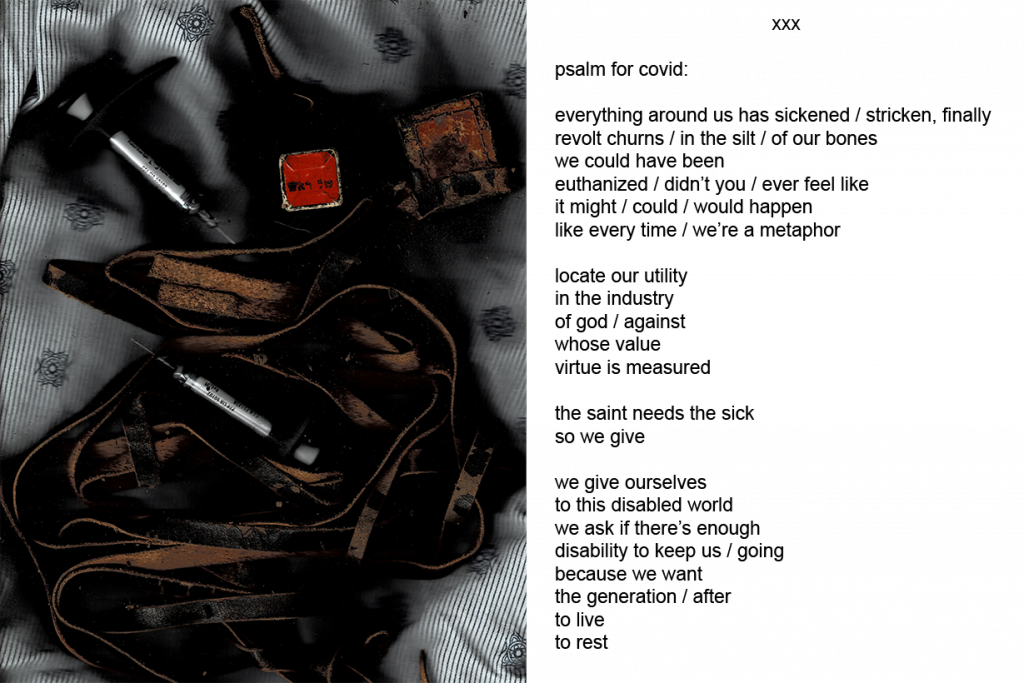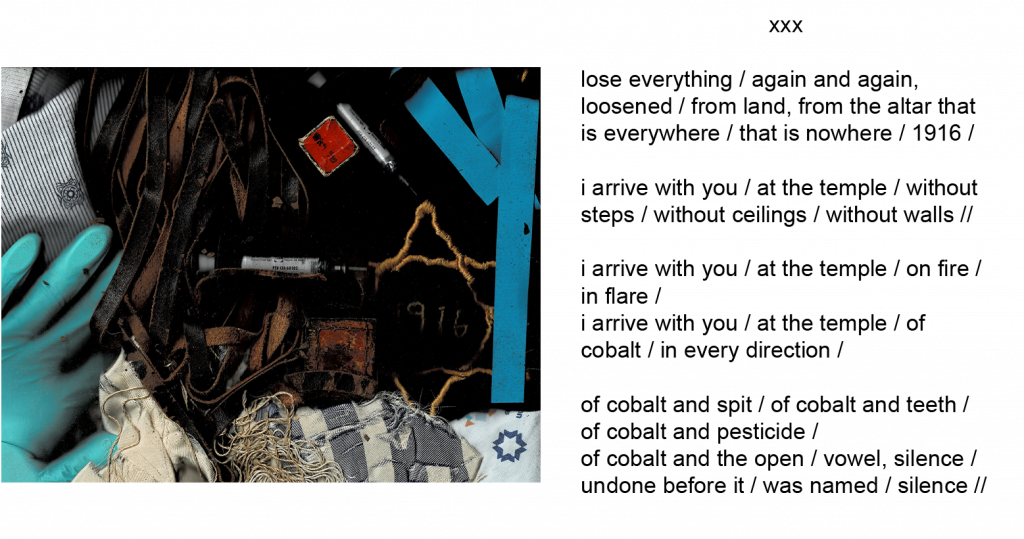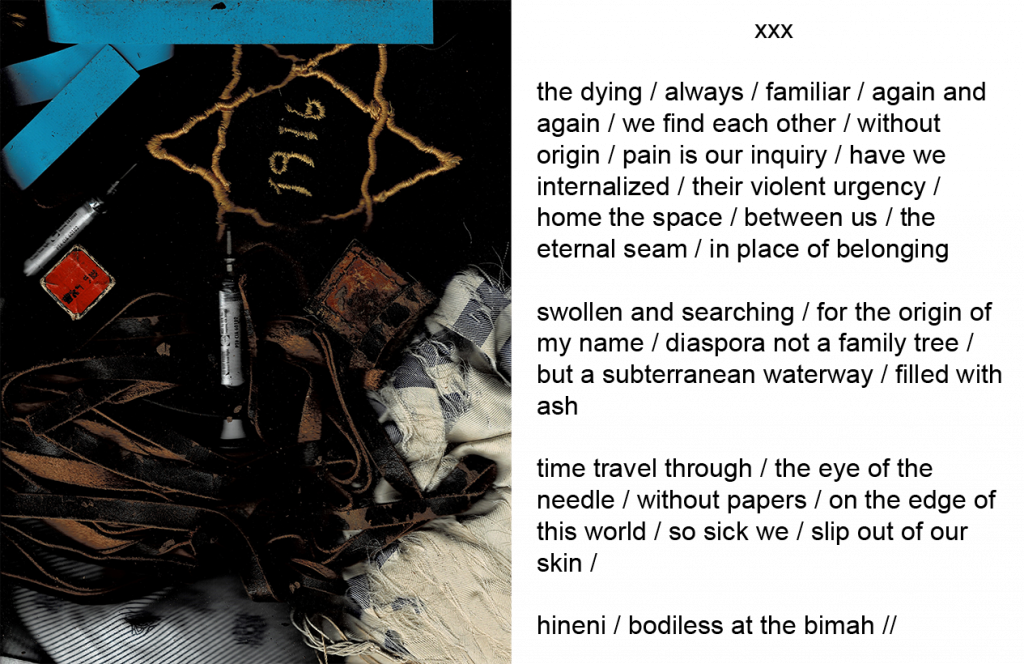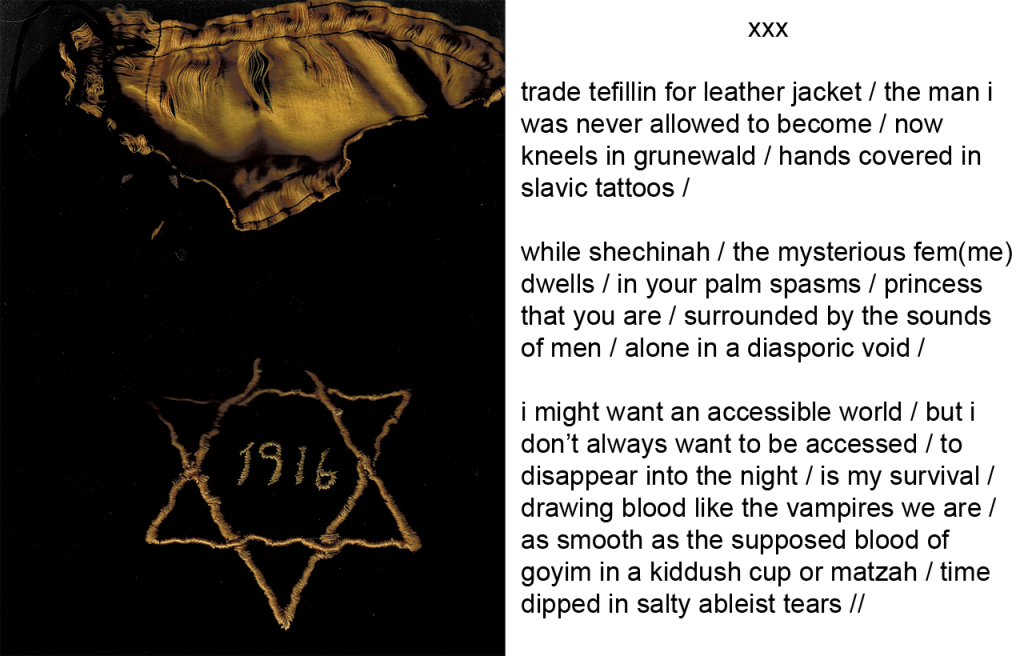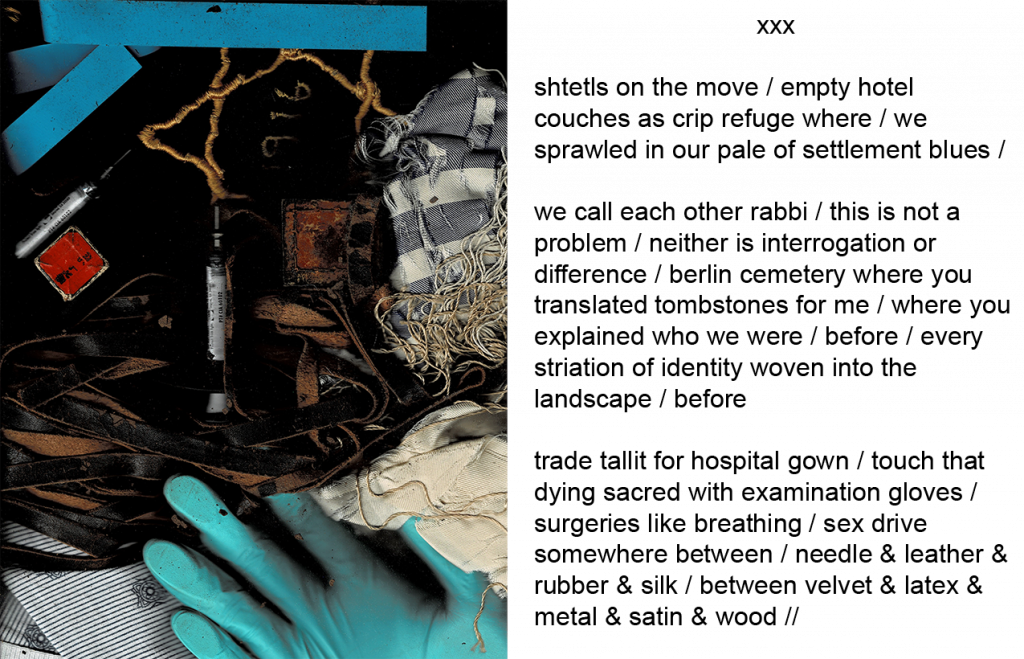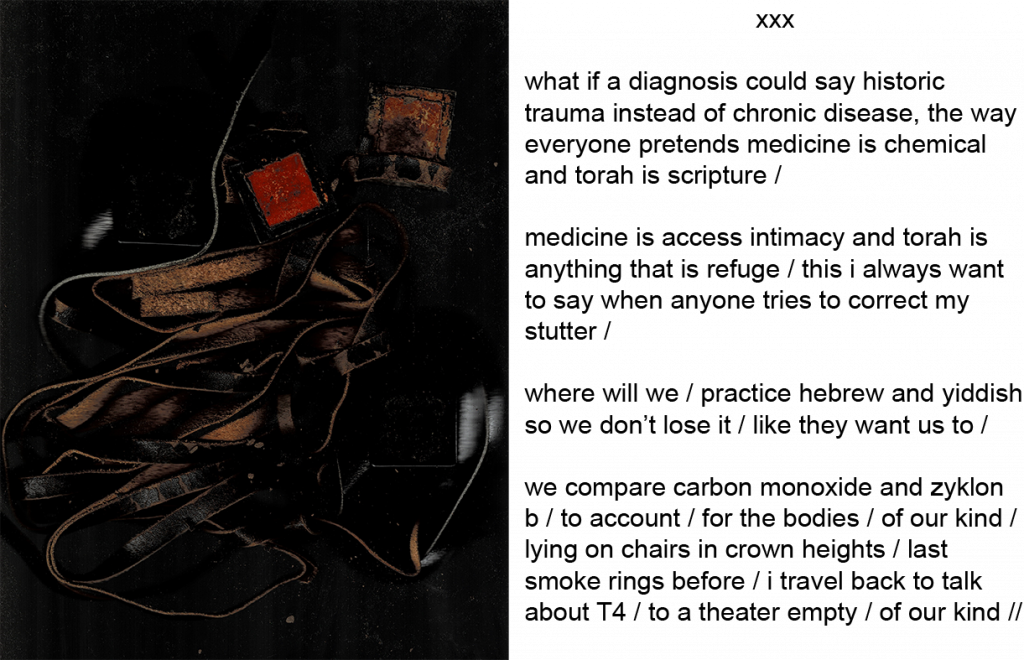Perel and Ezra Benus, Bodiless At The Bimah, Medium and Material: poetry and photo scan collage, Perel’s grandfather’s tefillin, tallit, and tallit bag, two of Ezra’s used syringes and worn hospital gowns, history, spirit, and love of disabled, queer, and Jewish people, 2020.
Note: For optimal viewing, view this on desktop. To navigate this work, please click the arrow on the left of the slideshow. Below are image descriptions and audio files listed in numerical order.
—
Disabled, Ashkenazi Jewish, Queer artists Ezra Benus and Perel collaborate on this hybrid work incorporating poetry and photo-scan collage. Bodiless At The Bimah explores the myriad measurements of time as experienced by the artists from the position of their shared subjectivities. As an inside joke, and a gesture to reclaim stigma, the artists adopted the term “vampire time,” which describes the far reaching, eternal experience of time / undead time / living as a creature of the night, where things come out / humorizing on and about the the many dark, fantastical fears non-Jews have historically placed onto Jewish people, such as being vampires. Similar fears and stigma have been placed onto sick, disabled, and queer people, of being non-sexual or hyper-sexual, and the general stigmatized experiences of sexuality and gender, all seen as deficient identities throughout time and space.
Related to this is the concept of “crip time,” which has been increasingly recognized in contemporary discourse of disability. Crip time is a term shared by and for disabled people/ crips which counters normative hegemonic modes of production, including the daily function of how one lives life. Crip time can be measured by how one copes from day to day, by doctor visits, time spent in bed, procedures, and any number of considerations that condition the lives of crips, to the historic notions of crip time that has hidden us from view. These ways of being in time inhabit the seam of existence, as we live between worlds. This artwork shows the extent to which our identities take up the space of the seam. From our lived experience, we share the knowledge that the cohesiveness of the body is an illusion, and that the real state of emergency amidst the current pandemic is not the urgency of momentary vulnerability but mainstream ignorance and the denial of vulnerability as an inescapable truth.
—
Note: Click here to read stanza #1 of the poem in 18 pt font size.
[Image description #1: On a black background is a photo scan of a turquoise nitrile gloved hand, palm opened with fingers apart, pressed onto, and entangled with black and brown leather straps of tefillin bunched and unraveled.On top is a small box of the tefillin containing handwritten scrolls liturgy and scripture on cow parchment, held inside for protection. The box has Hebrew writing “shel rosh” meaning “belonging to the head” written in black on a red background.]
1.
—
Note: Click here to read stanza #2 of the poem in 18 pt font size.
[Image description #2: Photo collage of tangled black and brown leather straps of tefillin bunched and unraveled on a black background. To the top right of the straps are the small boxes of the tefillin containing handwritten liturgy scrolls on cow parchment, held inside for protection. One box is red, the other box next to it is upside down revealing the brown worn leather underside.]
2.
—
Note: Click here to read stanza #3 of the poem in 18 pt font size.
[Image description #3: photo collage scan of many objects. In the center and lower left are tangled black and brown leather straps of tefillin bunched and unraveled, half resting on top of a blue and white thin striped hospital gown with star designs in the bottom left corner, and to the top resting on a black velvet tallit bag with a gold embroidered star of David with the year 1916. In the middle, on top of the tallit bag and the straps are used syringes, needles exposed with silicone grasps. To the left and right of the center are the small boxes of the tefillin containing handwritten liturgy scrolls on cow parchment, held inside for protection. The box on the left has Hebrew writing “shel rosh” meaning “belonging to the head” written in black on a red background, the other box on the right is upside down revealing the brown worn leather underside. To the right and at the border, is a blue and white striped tallit, with yellowed tassels of the tzitzit fringes visible. The image is held at the top and bottom with hospital blue-greens, at the top is a blue tourniquet, and at the bottom right border shows a nitrile turquoise gloved hand.]
3.
—
Note: Click here to read stanza #4 of the poem in 18 pt font size.
[Image description #4: Photo scan of a black velvet tallit bag with the top showing the gold inside, threads loose and torn, satin or silk like textures apparent from the shadows and shimmer. In the bottom center of the black velvet tallit bag is a gold embroidered star of David with the year 1916.]
4.
—
Note: Click here to read stanza #5 of the poem in 18 pt font size.
[Image description #5: photo collage scan of many objects. In the center and lower left are tangled black and brown leather straps of tefillin bunched and unraveled, half resting on top of a blue and white thin striped hospital gown with star designs in the bottom left corner, and to the top resting on a black velvet tallit bag with a gold embroidered star of David with the year 1916. In the middle, on top of the tallit bag and the straps are used syringes, needles exposed with silicone grasps. To the left and right of the center are the small boxes of the tefillin containing handwritten liturgy scrolls on cow parchment, held inside for protection. The box on the left has Hebrew writing “shel rosh” meaning “belonging to the head” written in black on a red background, the other box on the right is upside down revealing the brown worn leather underside. To the right at the bottom corner, is a blue and white striped tallit, frayed, and with one yellowed tassel of the tzitzit fringes visible. At the top of the image is a blue tourniquet.]
5.
—
Note: Click here to read stanza #6 of the poem in 18 pt font size.
[Image description #6: Photo collage scan of many objects. In the center left are tangled black and brown leather straps of tefillin bunched and unraveled, half resting on top of a blue and white thin striped hospital gown with star designs, and to the right resting on top of black velvet tallit bag with a gold embroidered star of David with the year 1916. In the middle, on top of the tallit bag and the straps are used syringes, needles exposed with silicone grasps. In the top and bottom of the center are the small boxes of the tefillin containing handwritten liturgy scrolls on cow parchment, held inside for protection. The box on top has Hebrew writing “shel rosh” meaning “belonging to the head” written in black on a red background, the other box next to it is upside down revealing the brown worn leather underside. Below it, is a blue and white striped tallit, with yellowed tassels of the tzitzit fringes visible. The image is held on both sides with hospital blue-greens, on the right is a blue tourniquet, and the left border shows a nitrile turquoise gloved hand.]
6.
—
Note: Click here to read stanza #7 of the poem in 18 pt font size.
[Image description #7: Photo collage scan of tangled black and brown leather straps of tefillin bunched and unraveled resting on top of a blue and white thin striped hospital gown with star designs. In the middle, and on the top left of the straps, are used syringes, needle exposed with silicone grasps. To the top right of the straps are the small boxes of the tefillin containing handwritten liturgy scrolls on cow parchment, held inside for protection. One box has Hebrew writing “shel rosh,” meaning “belonging to the head” written in black on a red background, the other box next to it is upside down revealing the brown worn leather underside.]
7.

